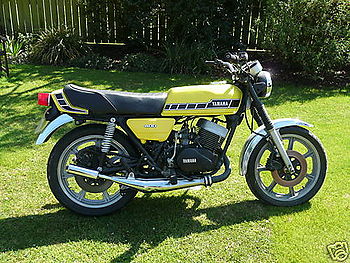Yamaha RD400/reviews
Yamaha RD400 1981 Road Test[edit | edit source]
How would you fancy a Yamaha RD400 that could blow machines with twice that capacity into the weeds? The idea appealed to reader Brian Dodson so he invested two years' work and a lot of money achieving just that.
It's not an idle boast, we speed trapped his bike at MIRA where it reached 125.69mph in fairly neutral wind conditions. We were impressed! We often hear from readers who claim that their bog-stock xyz goes 20mph faster than our road test version, but when you get down to the timing lights the bullshit stops.
To get the kind of speeds we were recording you need just one thing — power, and plenty of it! In fifth gear the engine would sing on to 10,000rpm and a genuine 121.54mph. In fact the power spread was one of the best things about this conversion, the other good point was the stability.
Even flat out the bike was rock steady and Brian achieved this with remarkably little in the way of modifications. The bike is fitted with taper roller head bearings which Brian says made a big difference. There is an air conversion on the front, drilling and tapping the original fork nuts to accept a GS1000 balancing kit. Pressure is set to 8 to 10 psi. At the rear Koni dampers control the stock swinging arm while damping at the front is helped by 30 weight Bel-Ray at 210cc per leg.
The engine tune is a story of gradual development over a couple of years, and Brian made a few mistakes along the way. Opening up the reed stops to 12mm lift helped the power, but the bottom reed broke up after several thousand miles. Fitting two six thou reeds cured this although Brian has now gone over to Boyesen Racing reeds after reading the report in MCN.
The cylinder heads have been lightly skimmed but Brian was still running with head gaskets so the squish could probably come closer yet. The barrels were ported by Stan Stevens Motorcycles at Sevenoaks in Kent and although we have no details on the port dimensions we have been assured that the holes are "big"!
To match up with the big ports, Brian bought a pair of 34mm Amal Mk11 carbs. These were fitted to the standard intake rubbers which were cut out to match the new carb bore — the same mod as our own shoot-out Yamaha RD250. The power range on the new port timings and the Amal carbs was very good but the addition of power jets, from Amal, helped things even further. Brian fine tuned the power jets by extending the feed nozzle with brass tube obtained from a radio shop. This brings the jet in earlier as the throttle opens and it really smoothed out the pick-up.
I checked with the Amal technical department on this point and they said it was perfectly acceptable to tune in the power jet in this way. Their standard jet length is a compromise for all the applications which the carb can be adapted to, with wild port timings on a two stroke, bringing the power jet in earlier helped smooth out the power delivery.
On the exhaust side Brian chose Allspeed Formula 111 expansion chambers. The centre stand cannot be used with these pipes but they do tuck underneath the engine, much like the LC model, and increase cornering clearance.
The plain section of the front pipe with the spring fitting made it a piece of cake to shorten the system. Brian took one inch off the down pipe and modified the back fitting bracket. This gave even better ground clearance and let the motor rev out higher.
In this very high state of tune the engine is remarkably flexible and easy to drive, as Brian says: "It is more like a tuned four stroke on the road with usable power from quite low engine speeds."
To cope with the extra power the clutch had to be beefed up. This is a common problem with mildly tuned RD400 engines so Brian had quite a problem! His answer was to visit no less than 40 bike shops searching for stronger clutch springs. Finally he discovered that Honda 125 inner VALVE springs could be fitted with just a little machining of the clutch pressure plate. Initially Brian had six Honda springs but found the pressure just too much. He now has three, with three standard springs and has had no trouble at all from the unit.
